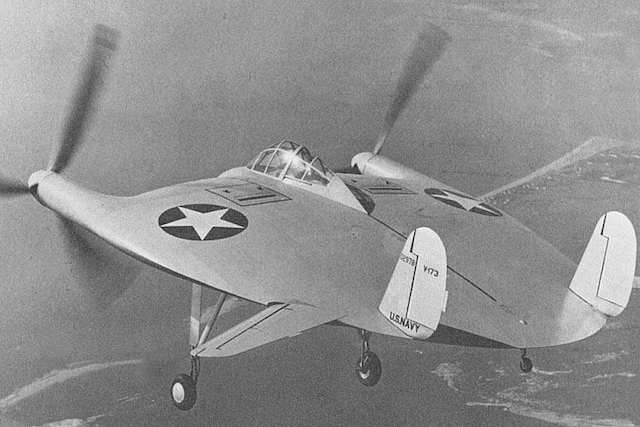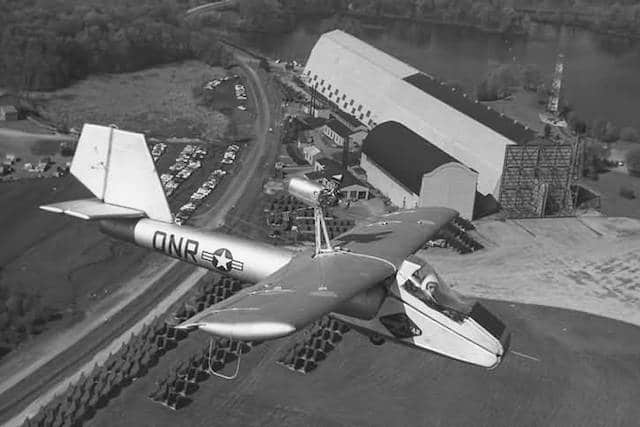The Wright Brothers didn’t exactly create an immutable set of design instructions for the world when they took that first flight in 1903 and really, it wouldn’t have mattered if they had. That they had proven flying machines could work was all that was necessary for the spirit of innovation to take hold in others. And look at us now, just over a century later, and we’ve produced over 150,000 different planes.
Some of those have proven to be immensely popular like the Cessna 172, of which over 44,000 have been produced. But then there are those that never really escape the prototype phase. Those aircraft that actually get into the air but not production. Most were average and forgettable, but these 10 were absolutely incredible.
10. The Aerodyne
Alexander Lippisch was a man with a dream and no desire to let the wisdom of the day keep him down. First flown in 1959, the Lippisch Aerodyne was what can best be described as a wingless plane. To look at it is to be baffled utterly as it appears to be a giant jet engine and little else.
The Aerodyne was a fluid sustained and fluid propelled aircraft. It achieved flight thanks to two coaxial propellers and flaps were used to divert the slipstream so that it could fly up or down. Test flights were conducted with unmanned versions of the plane, and it worked. A piloted version was planned but never implemented because there was no need for this kind of engineering, and the concept may have just been a little too far out.
9. The Nemeth Parasol
What do you get when a biplane and a flying saucer have a baby? The Nemeth Parasol. Looking at this plane with modern eyes you’d be forgiven for thinking there was no way it would get off the ground, but you’d be wrong. The Parasol did manage to get airborne.
Describe as a parachute plane, it used a massive round win rather than the horizontal wings we’re used to in order to maintain flight. Steven Nemeth, the inventor, claimed it was so easy to fly that you could master it in a tight 30 minutes even if you’d never flown a day in your life. Its maiden flight back in 1934 saw it get up to 135 miles per hour and then Nemeth stalled the engine. The result? The parachute wing did exactly what its name suggests it should do. It gently floated down to the ground for a soft landing.
Despite a successful test flight, no other Parasols were ever built. The parachute wing caused considerable drag that made flying one efficient compared to typical aircraft.
8. The Avrocar

How fascinated were people with flying saucers in the 1950s? Avro Canada’s VZ-9 Avrocar can adequately answer that. First designed by a Canadian firm in 1958 and then taken over by the United States military this vehicle was 100% designed to look and function like a flying saucer. And the only thing weirder than the fact it looked like a flying saucer was the fact that it worked.
The Avrocar functioned thanks to something called the Coanda effect. That’s the same phenomenon that will keep a ping pong ball floating on a jet of air from your leaf blower. It’s described as “the tendency of a fluid jet to stay attached to a convex surface” and can make a saucer-shaped craft stay aloft.
The plan was for the Avrocar to be a supersonic bomber capable of vertical take off and landing, and while it was capable of flight, during tests it proved to have serious issues with thrust and stability making it unreliable. The project was abandoned by 1961.
7. The Vertical Flyer
Also known as the SNECMA Coléoptère, this French craft was designed like a donut with a plane fuselage jammed in the hole. A single person plane, the point was to take off and land vertically thus eliminating the need for runways.
The closed annular wing had the cockpit held inside of it and served as the power source, the frame, and the wing for the plane. And it worked. Though the pilot was sitting on little more than an ejector seat on top of a jet engine, that was all that was needed. The Coléoptère managed eight successful test flights. It became so famous in France it even ended up in the comic book “Tintin.” But despite its relative success, it was not without issues. The lack of a delta wing meant it tended to slowly roll on its vertical axis and it was hard to steer. The test pilot even called the speed indicator a fantasy. On the 9th test flight, things went from problematic to catastrophic. Horizontal flight was only briefly achieved, but the pilot lost control and had to eject. The plane crashed and all future tests were scrapped.
6. Vought V-173

It’s hard to have a lot of faith in something that was known as the Flying Pancake but this goofy manta ray of the sky got the job done. A round fuselage flanked by two propellers; the Pancake took flight for the first time in 1942 utilizing a novel “all-wing” design that meant the entire plane created lift.
The propellers on the plane were 16.5 feet in diameter meaning that the plane had to sit at a 22-degree angle at rest, requiring the pilot to look out a window in the floor to see what he was doing at takeoff or landing.
After working out vibration issues, the plane was tested in successfully in Connecticut in 1942 and 1943 which prompted a number of locals to call the authorities with UFO sightings. Test pilot Charles Lindbergh praised its ability and handling and, thanks to its massive propellers and wing design, it was capable of near vertical take off. So why didn’t it last? The jet engine made it obsolete. No matter how efficient it was, it wasn’t fast and that meant it wasn’t needed.
5. Goodyear Inflatoplane

Balloons can fly, blimps can fly, and an inflatable plane can fly if you try hard enough to make it happen. Goodyear, the company famous for tires and their eponymous blimp, designed the inflatoplane in much the way inflatable rafts are designed. Made from rubber, it needed to be inflated to its usable shape and then put in motion. It took five minutes to inflate and required less air pressure than a car tire.
The plane seems silly when you first hear about it; why would anyone want or need an inflatable rubber plane? But the idea was sound and even noble. The plan was to drop an inflatoplane behind enemy lines as a rescue plane if a pilot was shot down. It could be inflated quickly and flown to safety, it was able to work on land or sea, and it was relatively cheap.
While it wasn’t breaking speed records, the inflatoplane had a cruising speed of 60 miles per hour and a range of 390 miles carrying 240 pounds. Tragically, one of the test pilots died during a flight when a control cable came loose and a piece of the wing frame hit the pilot in the head, knowing him from the craft. The project itself was ended shortly thereafter.
4. X-51 Waverider
Even though the Boeing X-51 WaveRider is an unmanned aircraft it 100% deserves recognition for being one of the most amazing aircraft ever created. It was what s known as a scramjet, a type of aircraft that relies on supersonic airflow for propulsion. It was tested three with little success starting in 2010 but in 2013 it completed a 6-minute flight including a 210 second run at Mach 5.1. That became the longest hypersonic flight ever. If you’re not all up to date on your Mach speed equivalents, Mach 5 occurs at just over 3,400 miles per hour. For comparison, the F-35 can hit about Mach 1.6, or 1,200 miles per hour.
The WaveRider was launched like a missile from another craft, in this case a B-52 Stratofortress. It actually had no wings of its own and instead rides on its own shockwave which is how it got its name. Because it was built as a means of demonstrating the technology rather than a functional craft it was never put into production after its test flights. Instead, the knowledge gained from what it did was applied to later designs for planes, surveillance systems, and weapons.
3. Solar Impulse

Renewable energy is the way of the future and while Tesla is leading the charge in terms of electric vehicles and solar power cells, the Swiss-made Solar Impulse put that technology to practical use by making a functional, solar-powered plane. And it wasn’t just a weak little butterfly-high puddle jump, either. In a July 2010 test it flew for 26-straight hours including 9 hours at night.
The team built an improved version with 17,000 solar cells and better power systems and began a flight in March 2015 that lasted all the way until July 2016. The journey began in Abu Dhabi and ended there as well. It was the first flight in history that traveled 26,000 miles around the entire globe in a plane powered by nothing more than solar energy at an average, leisurely speed of only 45 miles per hour.
2. Bartini-Beriev VVA-14
By now it should be clear that after mastering flight itself, mastering vertical take off was the main goal of nearly every plane designer in the world. The VVA-14 wanted to combine that with an aquatic plane that could be used by the Soviet Navy to monitor enemy submarines approaching Russia. In so many words it was a flying boat that just happened to look like a second-string Star Wars throwback.
The original design featured inflatable pontoons and later rigid ones and test flights were not a disappointment. It reached 32,000 feet and they flew it for over 1,500 miles. So far so good. The problem was the main feature of the plane was to be vertical take-off and the designer of VTOL engine was never able to come through on it. Without the engine that made it anything more than a futuristic-looking aquaplane, it got off the ground literally but not figuratively and the project was canned two years after its introduction with barely more than 100 hours of fight time completed.
1. HZ-1 Aerocycle
Strictly speaking no, this is not a plane. But it is an aircraft, it did fly, and it boggles the mind to this day, 70 years or so after its creation. The HZ-1 Aerocycle was a personal helicopter designed to be used by pilots with no experience at all and only 20 minutes of instructions. It takes about that much time to figure out how to use an Instant-Pot, and that doesn’t have rotating blades or the ability to travel at75 miles per hour.
Despite the fact that the dual sets of blades would sometimes collide during flights and that they’d kick up rock shrapnel, the project was pursued very enthusiastically by the military. Twelve of these devices were built, outfitted with airbags to cushion an otherwise rocky landing and they were successful enough until wind-tunnel testing began. Subject to unstable conditions these machines were unpredictable and suffered uncontrollable pitching. The idea was eventually scrapped for being too unreliable.